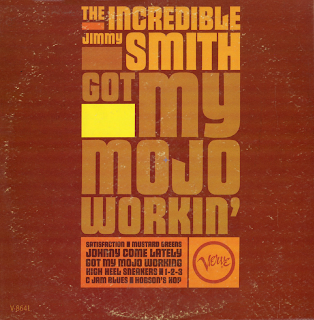Johnny Come Lately
The Incredible Jimmy Smith
Got My Mojo Workin'
Arranged and Conducted by Oliver Nelson
Kenny Burrell - Guitar
Grady Tate - Drums
Produced by Creed Taylor
Engineer: Rudy Van Gelder
Director of Engineering: Val Valentin
Verve V-8641
1966
December 6, 1965
Satisfaction, 1-2-3, Mustard Greens and High Heel Sneakers
Jimmy Smith - Organ
Kenny Burrell - Guitar
Ron Carter - Bass
Ben Tucker - Bass
Grady Tate - Drums
December 17, 1965
Got My Mojo Workin', C Jam Blues, Johnny Come Lately and Hobson's Hop
Jimmy Smith - Organ
Kenny Burrell - Guitar
Grady Tate - Drums
George Duvivier - Bass
Jerome Richardson - Baritone Sax
Phil Woods - Alto Sax
Romeo Penque - Tenor Sax and Flute
Ernie Royal - Trumpet
From the inside cover (gatefold): According to arrange-conductor Oliver Nelson, who has been deeply involved in several of Smith's recent successes, a feeling had developed that (without in any way wanting to pot down their organ-plus-big-band sound) it might be time for a change of pace – for something less formalized and more wide-open for blowing. Thus the first side of this album is strictly for Smith and rhythm section, with full solo room for the organist (and a couple of openings for the superior guitar talents of Kenny Burrell). On the second side Oliver comes into the picture with a few horns, mostly for backgrounds and interludes and ensemble 'stings." the rest for he time "full speed ahead for Jimmy" is the order of the day, and it works out just fine.
A final note on the power of Jimmy Smith's mojo can come from the 1965 Down Beat Readers Poll. Not only was he top choice on his instrument, as always, but his winning margin was the biggest in any category. And his total vote was more than double that of all other listed organists combined. How's that for knowing how to make everybody love you? – Orrin Keepnews
High Heel Sneakers
(I Can't Get No) Satisfaction
1-2-3
Mustard Greens
Got My Mojo Workin'
Johnny Come Lately
C Jam Blues
Hobson's Hop























